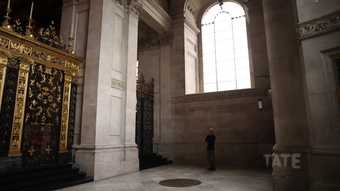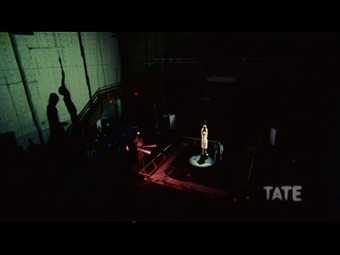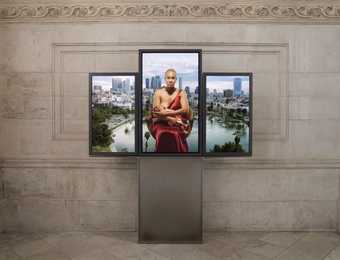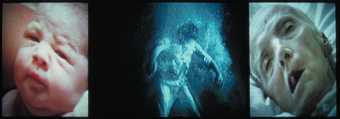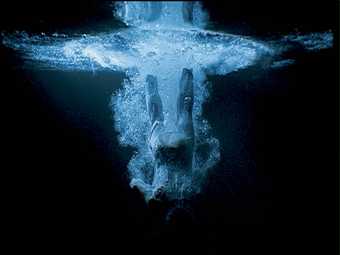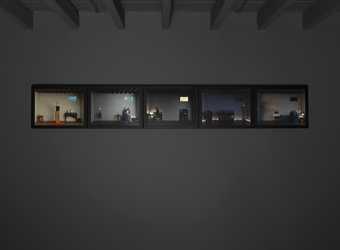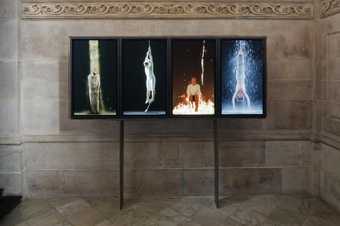Bill Viola's video installation, Ocean Without a Shore, was presented in the atmospheric setting of the church of San Gallo, Venice.
Monitors positioned on three stone altars in the church showed a succession of individuals slowly approaching out of darkness and moving into the light, as if encountered at the intersection between death and life. Viola talks about his artistic intentions and the technical challenges of the piece.
Bill Viola: Well here we are in front of the Church of San Gallo in Venice, Italy. This is a small church built in the sixteenth century and it’s a really extraordinary and beautiful small space that I was able to get for this special presentation of the new work, Ocean Without a Shore. So this is the entrance here, we are about to go into it. I first came here in January of this year and it had these three large alters. They are pretty imposing structures for such a small church so I didn’t really know exactly how I should approach this and even really what I was going to do. I was completely empty actually which is a blessing in disguise sometimes so I began to really focus on these alters and realised that as per the original development of the origins of Christianity these alters actually are a place where the dead kind of reside and connect with those of us, the living, who are here on earth. And they really are a connection between a cross, between a tomb and an alter - a place to pray. So I came up with this idea of the notion of the dead coming back to our world just temporarily. So you have these individual plasma screens mounted on the alters and each one is a separate individual. It shows a series of people, one by one coming towards us from a very dark obscure place. The image is black and white and they pass through this invisible threshold in the form of a wall of water which is so clear and transparent that you can’t see it. Then they actually step into seemingly this space and they become at that moment transformed into a high definition, highly detailed full colour image. In order to do this piece, we worked with two separate kinds of more or less unique innovative technologies. One is the water wall which is a device that’s about ten feet wide and it’s about eight feet high off the ground. It’s got a trough of water on the top and the water pours over a specially designed, laser cut, razor edge and the whole thing has to be completely level and the edge has to be aligned precisely. It takes three days to set up. When you get it right the water then maintains its coherency as it’s falling, until it pretty much gets very close to the ground. So you have what amounts to a sheet of glass that is completely transparent with no disturbance that you can see right through. The other innovative technology we use is a special optical device that was made especially for this project, designed by a group called PACE which works with the movie director, James Cameron. They designed us a special mirror prism system to align a state of the art, high definition video camera with this twenty five year old security black and white surveillance camera. And so it’s really like the origins of video, the oldest type video image that we have - the old analogue cameras from the ‘60s and ‘70s meeting the contemporary highest resolution, highest quality video camera known today and those two images, through this optical system, are superimposed. A lot of the shots you see in this piece were actually the first take with everybody. I spent time with each person individually talking with them and you know when you speak with people, you realise then that everybody has experienced some kind of loss in their life, great and small. So you speak with them, you work with them, you spend time and that comes to the surface while we were working on this project together, you know? I didn’t want to over-direct them because I knew that the water would have this kind of visual effect and so they were able to, I think, use this piece on their own and a lot of them had their own stories of coming back and visiting a relative perhaps, who had died. Or there was an elderly woman who came back to see her sister who had passed away eight years earlier and it was really interesting how people just sort of took this on their own and for me as a director, you know, that’s a beautiful thing, you just let the people bring to it what they have and what they actually need to express. I think I have designed a piece that’s open ended enough, where the people and the range of people, the kind of people we chose are from various ethnic groups and cultures. And I think that the feeling of more this is a piece about humanity and it’s about the fragility of life, like the borderline between life and death is actually not a hard wall, it’s not to be opened with a lock and key, its actually very fragile, very tenuous. You can cross it like that in an instant and I think religions, you know institutions aside, I think just the nature of our awareness of death is one of the things that in any culture makes human beings have that profound feeling of what we call the human condition and that’s really something I am really interested in. I think this piece really has a lot to do with, you know, our own mortality and all that that means.

